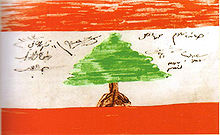Greater Lebanon
The state of Greater Lebanon ( Arabic دولة لبنان الكبير Daulat Lubnan al-Kabir , French État du Grand Liban ) was establishedas a French mandate area after the First World War , according to the scheme of 1920 to subdivide the Syria mandate into six states according to denominational aspects. Greater Lebanon, as part of Syria, was the predecessor of the modern Lebanese Republic founded in 1943. It was the successor to the Mutesarriflik Mount Lebanon .
history
After the Battle of Maysalun in 1920, General Gouraud proclaimed the establishment of the state of Greater Lebanon on September 1st within its present borders and with Beirut as its capital. The name Greater Lebanon refers to the incorporation of the former Ottoman districts of Tripoli and Sidon as well as the Bekaa Valley into the pre-existing former autonomous area of Mount Lebanon , which was founded in 1861 to protect the local Christian population . The Great Druze uprising from 1925 also affected Greater Lebanon.
The first Lebanese constitution (still valid today) was promulgated on May 23, 1926 and subsequently revised several times. In accordance with the Constitution of the Third French Republic , the Lebanese constitution provided for a bicameral parliament with a House of Representatives (the National Assembly ) and a Senate, its own President and a Council of Ministers, although the Senate was later abolished. The President had to be elected by the Chamber of Deputies for a six-year term and could not be re-elected until another six-year term had elapsed; the delegates had to be elected by the people along denominational lines.
The custom of choosing the most important political offices as well as the upper echelons within the public administration according to the proportions of the most important faiths in the population was coined during this period. The president should be a Maronite Christian, the prime minister a Sunni Muslim and the speaker of the Chamber of Deputies a Shiite Muslim. In theory, the Chamber of Deputies carried out the legislative function, but in fact the regulations were prepared by the Executive and submitted to the Chamber of Deputies, which accepted the laws without exception. Under the Constitution, the French High Commission continued to exercise supreme power, a deal that was initially rejected by the Lebanese nationalists. Nevertheless, Charles Debbas , a Greek Orthodox , was elected the first president of Greater Lebanon three days after the constitution was adopted. The first parliamentary elections took place in 1927.
At the end of Debbas' first term in 1932, Béchara El-Khoury and Émile Eddé competed for the office of president, thus dividing the Chamber of Deputies. To break this political deadlock, some MPs proposed Shaykh Muhammad al-Jisr , who was the chairman of the Council of Ministers and the Muslim leader of Tripoli, as a compromise candidate. However, the French High Commissioner Henri Ponsot suspended the constitution on May 9, 1932 and extended Debbas' term of office for another year; in this way he prevented the election of a Muslim president. Dissatisfied with Ponsot's behavior, the French authorities replaced him with Comte Damien de Martel , who on January 30, 1934 appointed Habib Pacha es-Saad as President for a one-year term; the term of office was later extended again for a year.
Émile Eddé was finally elected President on January 30, 1936. A year later he partially restored the 1926 constitution and decided that elections to the Chamber of Deputies should be held. However, the constitution was again suspended by the French High Commission in September 1939 when the Second World War broke out . The area quickly fell under the rule of the Vichy government and was thus - together with the Syrian Republic - a member of the Axis powers . In the Syrian-Lebanese campaign , the area was conquered by the Allies . In August 1943, the last parliamentary elections took place under French rule. Greater Lebanon gained full independence in 1943, but the French did not leave the country until 1946.
population
The population of Greater Lebanon was almost evenly divided between Christians and Muslims . In 1932 the French mandate power carried out a census in which the denominational distribution was determined. The total population was 785,542:
|
Christians
|
Muslims
|
Web links
- Library of Congress - Research - Country Studies - Lebanon - The French Mandate
- Concise History of Lebanon
- Glossary - Lebanon
- Milestones in Lebanon's Modern History
Individual evidence
- ↑ lcweb2.loc.gov
- ↑ Le grand Liban et la prize de pouvori des maronites en 1920.
- ↑ Anne-Lucie-Chaigne Oudin: La France et les rivalités occidentales au levant: Syrie-Liban, 1918-1939 in the Google Book Search, S. 62nd


